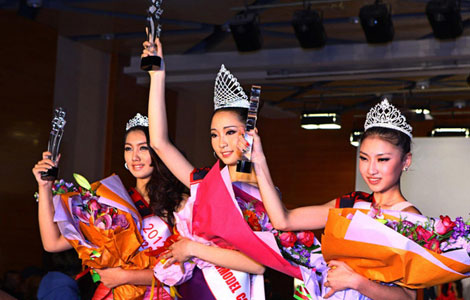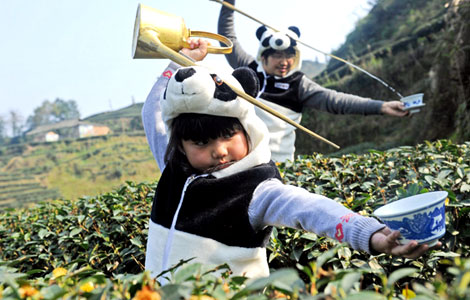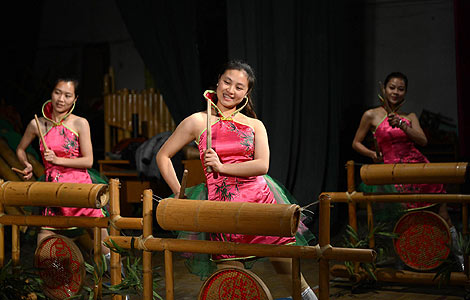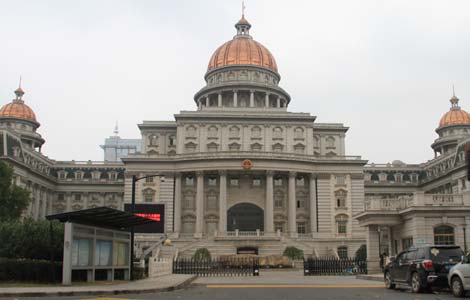
As foreign luxury brands compete to carve out portions of China's fast-growing market, experts are predicting that Chinese companies will soon develop luxury brands of their own.
It is time for domestic enterprises to establish luxury brands, since China has already become the dominant driver of growth in the luxury sector, said Zhou Ting, executive director of the research center for luxury goods and services at the University of International Business and Economics.
The sales volume of China's luxury market was 11.5 billion euros ($15 billion) in 2011, a year-on-year growth of 25 percent, according to PricewaterhouseCoopers International Ltd.
Potential domestic luxury brands could come from some traditional Chinese industries, including liquor, tea, porcelain and silk, said Yang Qingshan, a guest researcher of luxury goods and services at UIBE.
The research center listed 10 domestic brands with the potential to become luxury brands in its luxury report in November. Three liquor brands - Moutai, Wuliangye and Langjiu - are among the 10 brands. Zhuyeqing tea and some clothing brands, such as NE-Tiger and Shanghai Tang, are also on the list.
"Many traditional Chinese products already have a feature of luxury because of their heritage," Yang said.
However, many Chinese enterprises do not want to become luxury brands, since luxury is not a positive word in Chinese culture, as frugality is advocated, Yang said. "Chinese enterprises are usually conservative."
For example, the starting price for a bottle of Moutai liquor at a recent auction was 380,000 yuan ($60,000). But Ji Keliang, honorary chairman of China Kweichow Moutai Distiller Co Ltd, said that the company opposes labeling its liquor as a luxury product, Jiefang Daily Newspaper reported in November.
However, some Chinese enterprises have begun to change their attitudes toward luxury and intend to develop high-end brands.
Luzhou Laojiao Co Ltd, which operates the longest-running liquor cellar in China, released high-end bottles priced at 336,666 yuan each on March 16."Our liquor has two necessary features of luxury items, which are scarcity and heritage," said Zhang Liang, president of the company, according to the Beijing Times on March 17.
Zhang Zhifeng, chairman of NE-Tiger Fur Fashion Co Ltd, is also working on establishing a luxury-clothing brand."I aim to develop my company into one of the top international luxury brands," Zhang said.
Zhang intended to establish a luxury brand when he registered NE-Tiger in 1992, but some consumers said the company's reputation is still far from that of international luxury brands.
Creating a luxury brand is no small task, according to the UIBE researchers."It takes at least 30 years to develop a luxury brand," said Yang.
Merger and acquisition are faster methods of producing luxury brands, Yang said. Shanghai Tang became the first successful Chinese luxury-clothing brand after it was purchased in 2000 by Richemont Group, the world's second-largest luxury conglomerate by turnover. The transaction instantly promoted Shanghai Tang into an international luxury brand.
Meanwhile, Chinese investors are also trying to enter the international luxury market thorough investment and acquisition.
"Purchasing a luxury brand is a shortcut for Chinese enterprises by instantly acquiring a brand's heritage, which can span hundreds of years," Yang said.
As some companies in the West struggle amid the recent economic recession, it provides Chinese enterprises with ripe acquisition opportunities. But acquisition is not the best way for Chinese enterprises to enter the luxury market, experts say, since the acquired brands are still foreign and lack Chinese elements.
Although Chinese manufacturers still have a long way to go in the luxury industry, supported by a huge consumer base and rising incomes, Chinese luxury brands will soon emerge, said UIBE expert Zhou Ting.
Marketing is an important tool, which Chinese companies must learn from international luxury brands, Zhou added.
International luxury brands excel at telling their stories and connecting their brands with history, Zhou said.
"Chinese companies only make products, and none of them link their products to culture," said Xia Yang, president of Beijing Sunny Times Polo Sports Co Ltd.
Xia said Hermes can charge thousands of yuan for a scarf because the brand has historical value. Consumers buy not only its product but also its history and culture, he added.
Top 10 Chinese brands in 2011Moutai: China's top liquor brand and considered the national spirit of China. Its history can be traced back to the Han dynasty. Made by China Kweichow Moutai Distiller Co Ltd.
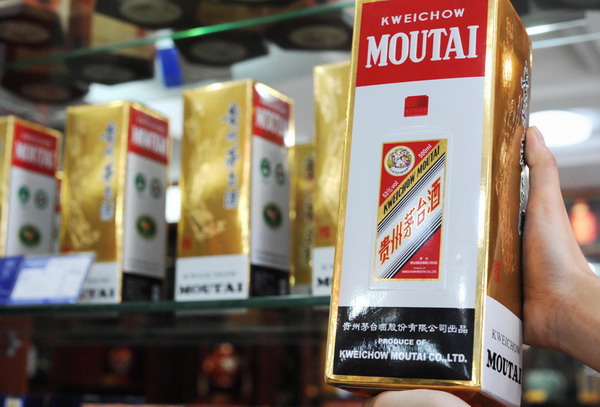 |
|
A bottle of Moutai liquor is presented at a store in Chengdu, Southwest China's Sichuan province in this file photo taken on March 28, 2012. [Photo/Xinhua] |
Wuliangye: Considered the second-best liquor brand following Moutai and has a history of more than 600 years. Made by Wuliangye Group Co Ltd in Yibin, Sichuan province.
Yue-Sai: A cosmetic brand established in 1992 by Yue-Sai Kan - a former TV program host. The brand was purchased by L'Oreal Group, one of the world's largest cosmetic and beauty companies, in 2004.
Zhonghua: A cigarette brand established in 1951 and supplied only to political leaders during its first 20 years. Made by Shanghai Tobacco (Group) Corp.
Lan: A jewelry brand founded by Yang Lan, a famous Chinese TV host, and singer Celine Dion in 2009.
NE-TIGER: A clothing brand established in 1992 which concentrates on high-end dresses and uses unique Chinese clothing techniques, including embroidery.
Zhuyeqing: A type of green tea produced in Emei Mountain, Sichuan province. Its products cost between 500 yuan ($79.30) and 5,000 yuan per 500 grams. The brand is owned by Sichuan Emeishan Zhuyeqing Tea Industry Co Ltd.
Langjiu: A liquor made using the same source of water as its rival Moutai and has more than 100 years of history. The brand is registered by Sichuan Langjiu Group Co Ltd.
Shanghai Tang: A clothing brand that was founded in 1994 in Hong Kong and is famous for its modern qipao and Chinese-style clothing. The brand was sold to Richemont Group in 2000.
Shanghai Vive: A cosmetic brand established in Shanghai in 1903. The product was popular among Chinese women and was well-known internationally in the 1930s. Shanghai Jahwa United Company Ltd relaunched the brand in 2010.
Source: Research Center for Luxury Goods and Services at University of International Business and Economics
wangwen@chinadaily.com.cn
